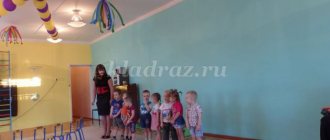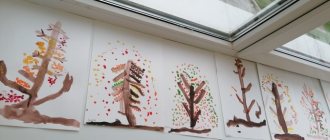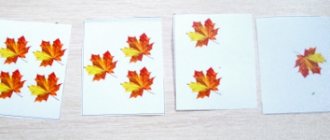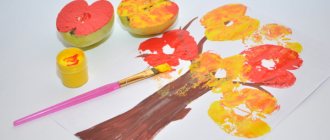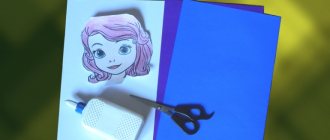Lesson topic: Autumn. Signs of autumn.
Age:
7-9 years
Conclusion:
ZPR of cerebral-organic origin.
Form
of lesson:
individual lesson
Type of lesson:
correction and systematization of knowledge
Topic of lesson:
Autumn. Signs of autumn.
Objectives:
1. Educational:
To consolidate the ability to observe seasonal changes in nature, knowledge of the names of the autumn months and the characteristic signs of autumn.
2.Developing:
Development of elementary mathematical concepts.
Development of coherent oral speech, development of the child’s fine motor skills. 3. Educational:
To cultivate the ability to understand and appreciate the beauty of our native nature.
Arouse interest in self-improvement, self-development, instill interest in classes. 4. Correctional:
Correction of higher mental functions (attention, memory, thinking); adjust and develop spatial concepts;
Methods:
verbal, visual, practical.
Equipment:
illustrative material on the topic, mood emoticons, temporary presentation board.
Progress of the lesson:
I. _ Organizational stage.
-Hello!!!
What's your mood now? Choose from the suggested images to suit your mood. (MOOD SMILES) II. Updating knowledge. Work on the topic.
- Development of temporal representations.
The defectologist reads a poem:
Leaves from trees in the forest are falling off.
The rain is pattering sadly on the roofs.
The bright sky says goodbye to the earth
Gloomy autumn is knocking on the window.
- What time of year do you think the poem is talking about?
- Name the autumn months?
- What can autumn be called in September? (early, golden).
— What can you call autumn in October? (rainy).
— What can you call autumn in November? (late).
- Introductory conversation
– What can you say about the sun in autumn?
(It doesn’t heat well, there are fewer sunny days).
—What is the sky like in autumn? (Gloomy, heavy, cloudy, rainy, cloudy, gray, dark).
— What happens to the trees in the fall? (Leaves: turn yellow, turn red, fall off, dry out. The trees stand bare.)
— What is the name of the phenomenon in nature when leaves fall from trees? (Leaf fall).
— Leaves in autumn, what do they do? (They turn yellow, turn red, dry up, fall, spin, fly, crumble)
— What happens to the grass in the fall? (Dries up, turns yellow, fades)
— What do birds do in the fall? (They fly away to warmer climes)
- Why? What are these birds called? (Migratory)
— What do insects do in the fall? (They hide in old stumps, snags, climb under the bark of trees).
— What do animals do in the fall? (They are preparing for winter. Some go to bed for the whole winter - a bear, a hedgehog, a badger. Others change their skin - a hare, a squirrel, a fox. Still others make supplies for the winter - a squirrel, a hedgehog.)
— What is the weather like in autumn? (Cold, rainy, windy, sometimes snowing.)
- What happens only in autumn? (Harvest, birds flying away, leaves falling.)
III. Development of fine motor skills. Finger gymnastics. Autumn scattered leaves (make wave-like movements with palms) Decorated them with a brush. (make smooth waves with their palms up and down) We will go into the autumn forest, (“walk” with the fingers of both hands) We will collect leaves into bouquets. (they cross their palms with their fingers spread out) A maple leaf, an aspen leaf, (they bend their fingers one by one, starting with the thumb, on both hands at the same time to the name of each leaf) An oak leaf, a mountain ash leaf, a red poplar leaf and jumped down onto the path. (clap hands loudly) IV. Development of hand-eye coordination.
- "Find according to the diagram"
Goal: development of spatial thinking and perception. A drawing is placed in front of the child, which shows a diagram of the path he must take to get to the goal. V. Correction of higher mental functions.
- Game "Pick the sign"
. Children select signs for the word “autumn” using mnemonic pictures.
Autumn (what?) - ... (Cold, rainy, golden, colorful, colorful, fruitful, warm, cloudy, clear, snowy, cheerful, sad, deciduous, etc.)
- The game “What doesn’t happen in autumn?”
Snowdrops do not grow in autumn.
In autumn they don’t swim in the river.
They don't sunbathe in autumn.
In autumn they don't wear fur coats.
VI. Development of elementary mathematical concepts.
- "Right left"
Goal: automation of concepts from right to left
Pictures or postcards depicting several children or animals. The child is asked to answer the question: “Who is sitting to the right of the bear? Name everyone who sits to the left of the bunny,” etc. The same exercise can be done with toys or any objects, placing them on the table.
VII. Development of coherent oral speech. Consolidation of knowledge. “Expand and tell” Goal: Establishing cause-and-effect relationships, developing coherent speech. The student receives a series of pictures on the topic of the lesson. His task is to select picture-episodes in the right order and convey the content of each, thus composing a whole story. VIII. Results of the lesson. Reflection. -What did you and I do today? - Well done, we did a great job today. — Name your associations.
Handing out homework.
Russia, Republic of Tatarstan, Aznakaevsky district, town. Aktobe MBDOU “Combined kindergarten No. 1 “Ogonyok” Educator Vishnevskaya L.V.
Class type: comprehensive
Type of lesson: educational
Program content:
- Systematize children’s knowledge about autumn and autumn phenomena;
- Continue to learn how to make sentences based on pictures, and from them a short story.
- Continue teaching children to answer questions in complete sentences.
- Develop fine motor skills of the fingers through finger exercises.
- Continue to develop memory and thinking through games and exercises.
- Cultivate a friendly attitude towards each other and the environment.
Methodical techniques: Visual: looking at illustrations, showing; Verbal: teacher’s example, questions, speech exercises, Practical: didactic games and exercises.
Material:
- flannelograph
- pictures with signs of autumn
- plot pictures for writing stories
- ball
- autumn leaves
Vocabulary work: turn yellow, drop, leaves fall, dry, sun, leaves.
Preliminary work : reading poems about autumn by F. I. Tyutchev, A. K. Tolstoy, P. M. Pleshcheev, A. S. Pushkin. Game “Match the object to the signs”, learning poems about the autumn months.
ORGANIZATION OF THE CLASS
Progress of the lesson
- Guys, listen to the riddle story. Try to guess what time of year we are talking about.
“The leaves rustled in the forest, and it seemed as if someone was walking under the maples and birches, and where they passed, the leaves turned red and golden. Now you won’t even recognize your native forest, your native clearing, your native lake. The flowers withered and withered, the grass darkened. Everyone was busy, everyone was preparing for the coming of winter. The birds took off from their places and flew in flocks to the warm blue seas.”
(excerpt from O. Ivanenko’s story “Good Night”)
- Guys, what time of year are we talking about here? (about autumn)
- How did you guess? (the grass turned yellow, the birds began to fly away)
- Who else knows the signs of the onset of autumn? (children's answers)
— And also, guys, the wind blows more often in the fall. Today it has been blowing since the morning, I met him on the way to kindergarten and he gave me a magic ball.
“The autumn and magical ball will jump into your hands and ask questions.” Let's stand in a circle. Whoever I throw the ball to must answer my question. For the correct answer I will give an autumn leaf.
- leaves in autumn (what do they do?) - leaves turn yellow and fall off in autumn
-rain in the fall (what does it do?) -rain in the fall is drizzling, falling.
-harvest in the fall (what do they do?) -harvest is harvested in the fall.
- birds in the fall (what are they doing?) - Birds fly away in the fall.
-trees in the fall (what do they do?) - Trees shed leaves in the fall.
- animals in the fall (what are they doing?) - Animals in the fall prepare for winter, change their coats.
Physical exercise (finger gymnastics) “Autumn bouquet”.
- Guys, let's collect an autumn bouquet. In chorus. One, two, three, four, five - Let's collect leaves. (Clench and unclench your fists). Birch leaves. Rowan leaves, poplar leaves, aspen leaves, oak leaves (bend your fingers one by one). We will collect an autumn bouquet in a vase. (Clench and unclench your fists).
-Well done boys!
Compiling stories based on individual plot pictures.
Wind chimes sound. A boy dressed as an autumn wind runs in and scatters colorful leaves near the board. The boy runs away.
- Guys, the wind ran towards us and scattered the leaves, look how beautiful they are, we need to collect them. Pick up one leaf at a time. (Story pictures about autumn signs are glued to the leaves.)
- Guys, come up with a short story for your picture, and we will connect all the leaves, and we will get a big autumn book.
(Compiling stories based on plot pictures on the theme “Autumn.”)
Autumn has come. The sun peeks out from behind the clouds less and less. The trees put on a colorful outfit. Red and yellow leaves fall, swirl, and cover the ground with a golden carpet. It often rains coldly. Birds gather and fly away to warmer climes. Animals make provisions for the winter. The children went to school in the fall. Mushrooms and berries grew in the forest. People are harvesting and preparing for winter.
Summary of the lesson.
Look what a beautiful, big book we have turned out to be. We will put it in a corner of nature and in the future we will make other books about winter, spring and summer.
- Now our lesson has come to an end, tell me, guys: What time of year did we talk about in class? What happens only in autumn? (Harvest, birds flying away, leaves falling.)
